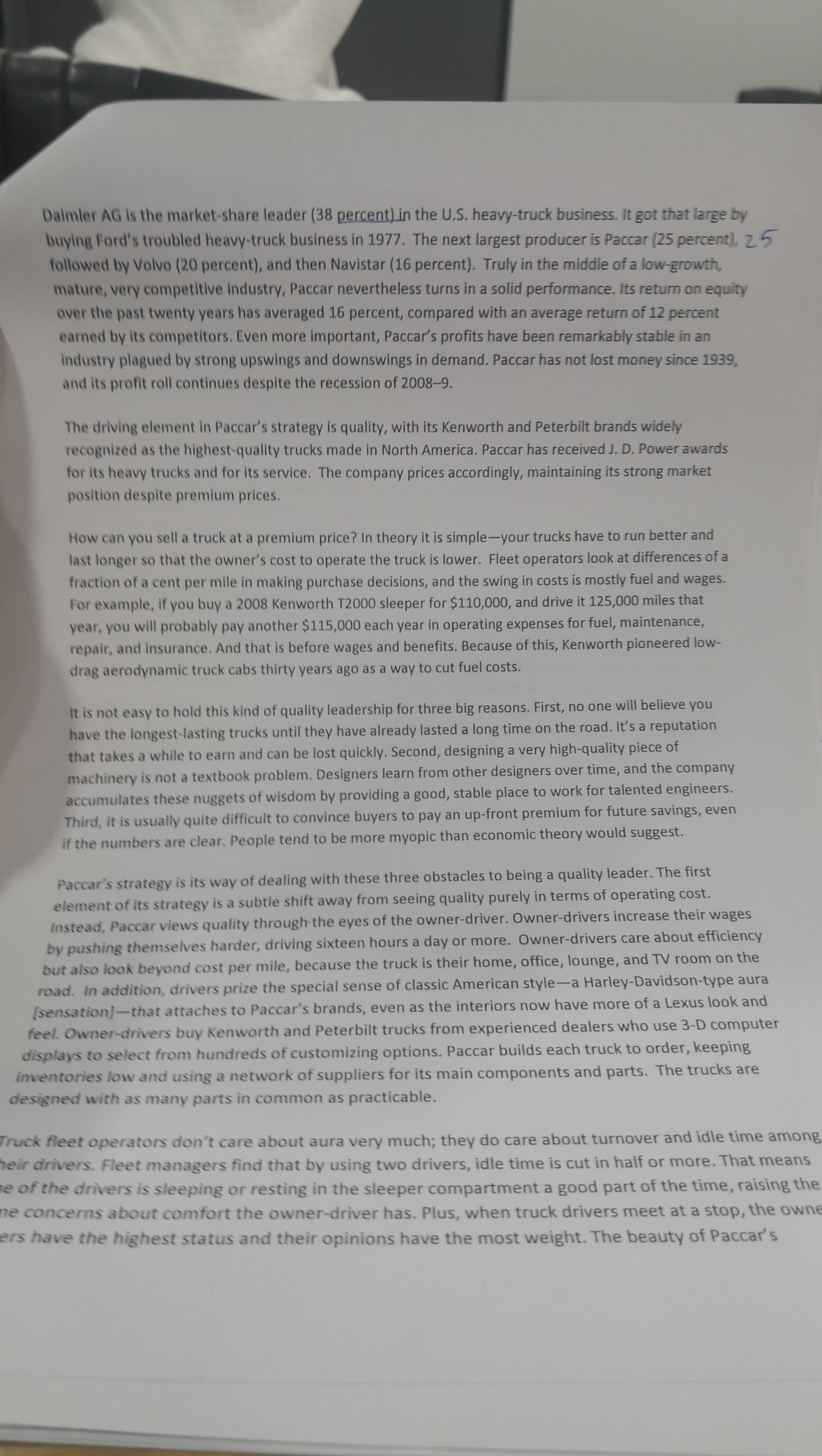Plz answer :
describe Paccar's strategies positioning? evaluate the strength of five forces of heavy truck industry? show how successful /unsuccessful Paccars strategy is in dealing with the impact of those forces? assess the source of sustainability /unsustainability of Paccars position?
Daimler AG is the market-share leader (38 percent) in the U.S. heavy-truck business. It got that large by buying Ford's troubled heavy-truck business in 1977. The next largest producer is Paccar (25 percent), 2 5 followed by Volvo (20 percent), and then Navistar (16 percent). Truly in the middle of a low-growth, mature, very competitive industry, Paccar nevertheless turns in a solid performance. Its return on equity over the past twenty years has averaged 16 percent, compared with an average return of 12 percent earned by its competitors. Even more important, Paccar's profits have been remarkably stable in an industry plagued by strong upswings and downswings in demand. Paccar has not lost money since 1939, and its profit roll continues despite the recession of 2008-9. The driving element in Paccar's strategy is quality, with its Kenworth and Peterbilt brands widely recognized as the highest-quality trucks made in North America. Paccar has received J. D. Power awards for it's heavy trucks and for its service. The company prices accordingly, maintaining its strong market position despite premium prices. How can you sell a truck at a premium price? In theory it is simple-your trucks have to run better and last longer so that the owner's cost to operate the truck is lower. Fleet operators look at differences of a fraction of a cent per mile in making purchase decisions, and the swing in costs is mostly fuel and wages. For example, if you buy a 2008 Kenworth T2000 sleeper for $110,000, and drive it 125,000 miles that year, you will probably pay another $115,000 each year in operating expenses for fuel, maintenance, repair, and insurance. And that is before wages and benefits. Because of this, Kenworth pioneered low- drag aerodynamic truck cabs thirty years ago as a way to cut fuel costs. It is not easy to hold this kind of quality leadership for three big reasons. First, no one will believe you have the longest-lasting trucks until they have already lasted a long time on the road. It's a reputation that takes a while to earn and can be lost quickly. Second, designing a very high-quality piece of machinery is not a textbook problem. Designers learn from other designers over time, and the company accumulates these nuggets of wisdom by providing a good, stable place to work for talented engineers. Third, it is usually quite difficult to convince buyers to pay an up-front premium for future savings, even if the numbers are clear. People tend to be more myopic than economic theory would suggest. Paccar's strategy is its way of dealing with these three obstacles to being a quality leader. The first element of its strategy is a subtle shift away from seeing quality purely in terms of operating cost. Instead, Paccar views quality through the eyes of the owner-driver. Owner-drivers increase their wages by pushing themselves harder, driving sixteen hours a day or more. Owner-drivers care about efficiency but also look beyond cost per mile, because the truck is their home, office, lounge, and TV room on the road. In addition, drivers prize the special sense of classic American style-a Harley-Davidson-type aura [sensation]-that attaches to Paccar's brands, even as the interiors now have more of a Lexus look and feel. Owner-drivers buy Kenworth and Peterbilt trucks from experienced dealers who use 3-D computer displays to select from hundreds of customizing options. Paccar builds each truck to order, keeping inventories low and using a network of suppliers for its main components and parts. The trucks are designed with as many parts in common as practicable. Truck fleet operators don't care about aura very much; they do care about turnover and idle time among eir drivers. Fleet managers find that by using two drivers, idle time is cut in half or more. That means e of the drivers is sleeping or resting in the sleeper compartment a good part of the time, raising the ne concerns about comfort the owner-driver has. Plus, when truck drivers meet at a stop, the owne ers have the highest status and their opinions have the most weight. The beauty of Paccar's







